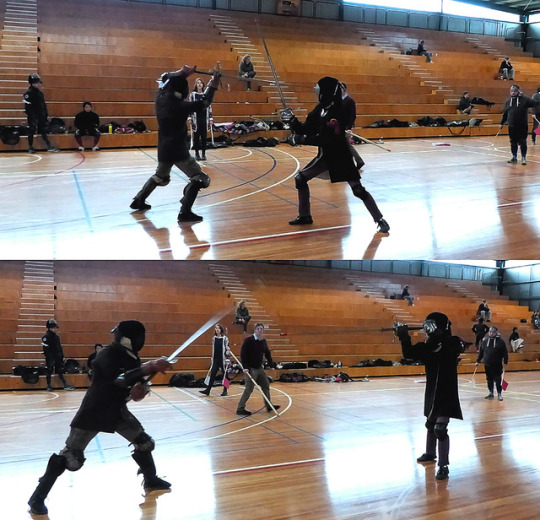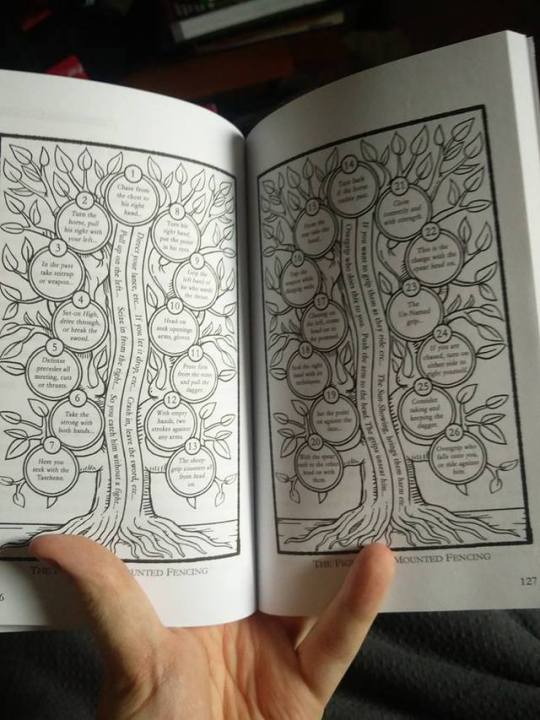Link
Since everyone is locked indoors, or will be soon, I discounted my book. It costs 10 bucks now instead of 15.
Let me know how you like it!
30 notes
·
View notes
Photo

Spadones in action at an experimental two-handed sword tournament, Melbourne.
Photo credit: Jo Pitts
100 notes
·
View notes
Text
Intensity versus Power
The confusion between the meaning of these two terms in Historical Fencing seems to come up a lot.

If you touch without power it does not necessarily mean you are fencing without intensity. If you fence with a lot of power, it does not necessarily mean you are fencing with a lot of intensity.
Though they exhibit a lot of overlap, they are not the same thing.
68 notes
·
View notes
Link
I reviewed my new swod, it’s cool and you might want one!
Follow my group on facebook already
#sword#feder#fencing#hema#liechtenauer#meyer#fechtschule#bloss#weapon#foil#review#equipment#sparring#combat#medieval#renaissance#longsword
3 notes
·
View notes
Photo
Here’s a video of Arto Fama and Rob Runacres beating someone up.

The game of Civettino
Giovanni di ser Giovanni Guidi from Florence, painted the attached image around 1450.
Depicted is a game or exercise called Civettino (Little Owl) - I can find only sparse information on the game, but have sourced the rules as requiring the players to stand on each others feet, planting them in place, and then play some kind of slap-boxing game, avoiding the attacks of the other by shifting weight and stance.
The central figure in the painting is playing against two opponents.
The relevance to an exercise like this to historical martial arts training seems undeniable. Such a game would be good not only for raising the heart rate and learning some timing, but perhaps give a nice encapsulated way to practise weighting the stance differently, as Fiore shows with his volta of the feet.
The clothes worn are standard for athletic activities of the time and training.
If anyone has more details about this game or regional variations, it would be great to know about it.
38 notes
·
View notes
Link
200 copies of this now found their homes with people around the world. I wish I had stats for where most of the orders shipped to so far but unfortunately I don’t. I feel pretty OK with how the book is performing so far, didn’t really go into it with any particular expectations. If you’ve got any thoughts about it feel free to PM them to me here!
I translated a manuscript about fencing with a two handed sword. The original is from 1452. I published it as part of the efforts of my training and research group, the Melbourne Fencing Society. If you are local, come and say hi.
Some key features of my translation:
All three disciplines have been translated by me. Fencing with the sword in two hands on foot without armour, fencing on horseback with the sword and the lance, and fencing in armour on foot with sword, lance, dagger, and wrestling.
The original work is a commentary explaining the meaning of fencing actions based on a much older poem about the topic. The actions are translated into as plain english as possible with lots of explanatory notes on the original document, but without trying to tell you how you should practise them.
The poem is included as in the original and has been painstakingly made to rhyme in english. This may assist in using the material as the original was used: as a memory aid.
Introductory material is included to place the work in its historical context, as well as an inspirational foreword by champion longswordsman, Martin Fabian.
The illustrations of the original have been recreated and dressed up in my own way. The key elements of the images have been carefully copied while taking care to make the images my own property, so the library to which the manuscript belongs does not sue me. Images of the original document can be browsed here.
I tried to keep this one as affordable as possible, so even if you are not sure you will benefit from it that much, it won’t set you back too much.
26 notes
·
View notes
Text
I would love to be able to try such an experiment. Maybe we can have a go at it here...
I enjoyed yesterday’s training. It was the first class I’ve lead in ages, and it was structured very differently. Rather than “let me show you how I do X” or “the book says to do this when you want to X”, I went for “go do X and show me how you found works best”. A different way to approach teaching, but it seemed to meet the Fit, Fun, Functional goals pretty well.

I’ve got perhaps three more sessions of material in mind on the same theme of “inventing I.33”. Hopefully, we’ll start with basic premises such as:
I want to hit someone with a sword [I’m likely to cut down from my dominant side]
I want to protect my nearest targets from the other fencer’s sword [using the buckler to protect an extended sword arm is a good idea]
If I stand there and cover a cut, there’s a risk of leg hits if they’re actually cutting low [Possibly ways to counter this are to immediately threaten a thrust off my cover, to retreat with the cover, or to make the legs a relatively less shallow target by hip hinging forwards]
And via sparring games/focused drills we’ll invent I.33. Hopefully.
The first session was extremely basic cuts, learning how an arming sword handles and coordinating it with buckler cover of the sword hand. We then introduced using the sword and/or buckler to cover a direct “caveman” head attack. It semi-organically led to a bind situation! Success!
Next session will be similar stuff on the other diagonal axis, and then thrusts and breaking them, going as far as schilt-schlach and stich-slach if we go fast.
I find that knowing the “why” makes a huge difference in the quality of repetitions - for example, the final drill we did of attack/counter-cut where one person is trying to cut to the head while not exposing the sword hand and the other is trying to cover the cut while likewise not exposing additional targets and lining up a thrust. It’s easier (in my brain anyway) to know what I want the technique to achieve and work to do that than to record a perfect and idealised form of it to mimic.
If you can handle his prose style, I have some good Luis Preto stick fighting books that discuss “ecological” training as superior to teaching forms.
46 notes
·
View notes
Link
I translated a manuscript about fencing with a two handed sword. The original is from 1452. I published it as part of the efforts of my training and research group, the Melbourne Fencing Society. If you are local, come and say hi.
Some key features of my translation:
All three disciplines have been translated by me. Fencing with the sword in two hands on foot without armour, fencing on horseback with the sword and the lance, and fencing in armour on foot with sword, lance, dagger, and wrestling.
The original work is a commentary explaining the meaning of fencing actions based on a much older poem about the topic. The actions are translated into as plain english as possible with lots of explanatory notes on the original document, but without trying to tell you how you should practise them.
The poem is included as in the original and has been painstakingly made to rhyme in english. This may assist in using the material as the original was used: as a memory aid.
Introductory material is included to place the work in its historical context, as well as an inspirational foreword by champion longswordsman, Martin Fabian.
The illustrations of the original have been recreated and dressed up in my own way. The key elements of the images have been carefully copied while taking care to make the images my own property, so the library to which the manuscript belongs does not sue me. Images of the original document can be browsed here.
I tried to keep this one as affordable as possible, so even if you are not sure you will benefit from it that much, it won’t set you back too much.
#danzig#german#longsword#hema#treatise#instruction#manual#fightin#sword#combat#renaissance#medieval#larp#enactment#fencing#fechten#fighting#duelling#duel#swordcraft#real#techniques#writing#fanfic#historical#historic#swordfight#swordfighting#liechtenauer#behourd
26 notes
·
View notes
Text
“If the tongue could cut by its nature, And strike as well as the sword can, The dead would be countless.”
-Philippo di Vadi, 1480s
15 notes
·
View notes
Text
“Don't think yourself expert, but that you may become so.”
-L’Abbat, 1734
26 notes
·
View notes
Video
youtube
Strapped cameras to peoples heads and did some fencing. For your enjoyment, of course!
Learn more about our group here.
#hema#longsword#fencing#combat#military#larp#re-enactment#swords#liecthenauer#kdf#fiore#rpg#fpv#fps#game#fighting#sword
6 notes
·
View notes
Photo

Jan Chris Plaggemars Doing The Thing
https://www.facebook.com/100004823232570/videos/933836073453825/
63 notes
·
View notes
Photo


I forgot to post here.
I got a proof print of my book in the mail a week or so ago. I am pretty happy with it. A few things i will do differently layout-wise next time, but it’s fine.
Waiting on a foreword and then it will be ready to go. The final came out to like 220 -ish pages.
#book#fencing#hema#martial#arts#combat#medieval#source#danzig#german#fechten#rapier#foil#longsword#mounted#lance#armour
6 notes
·
View notes
Photo


So I bought a super durable case for my new gopro and tried to get some first person sparring footage.
I unfortunately messed up. It was the first time i’d tried controlling the camera from my phone, and accidentally had it set to timelapse mode. So it’s very low framerate (meaning no image stabilisation) and very long exposure (meaning blurry images)
However, the footage in general shows some promise for what I can come up with if I am less of an idiot next time.
I think i want to aim the camera a little bit more downwards and put it on the highest FoV possible (this was on mid range FoV)
#gopro#fpv#firstperson#fps#combat#game#kingdom#come#warband#bannerlord#sword#fighting#fencing#medieval#german#liechtenauer#kdf#longsword#fechten#escrime
10 notes
·
View notes
Text
It is the same as when someone wants to learn to write; if they wish to aquire this skill, then they must practice hard and often, however difficult it may seem, even to the point of impossibility. If they do that, they will master the art of writing, although of course they will at first have to concentrate on every letter and commit it to memory. But then, when they have acquired this skill, they will no longer have any need for the image or the concentration, but will write freely and spontaneously. The same is true of learning to play the violin or anythingelse which is based on the acquisition of a skill.
All that is necessary is that someone should desire to perform their art, and then, whether they are concentrating upon it or not, they are able to perform on the basis of the skill which they have acquired. Thus we should be permeated with the sense of a divine presence and be in-formed with the form of our beloved God and be so established in him that we see his presence effortlessly and, more than this, remain unencumbered by anything, free of all things But this will initially demand of us much application and concentration, as any art does of one who will learn It.
Maister Eckhart, 14th century
…Speaking about how to be mindful of ones spirituality, but leaking also information about how skills and arts were understood to be learned at the time.
15 notes
·
View notes

